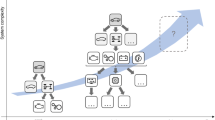Abstract
Product development involves many experts collaborating to the same design goal. Every expert has his own formalisms and tools leading to a high heterogeneity of information systems supporting design activities. Interoperability became a major challenge to avoid information incompatibility along the product life cycle. To synchronise heterogeneous representations of product will be a major step to integrate expert activities. In this paper, the authors propose a meta-model framework to connect together heterogeneous design models. This meta-model framework is used to formalise possible interactions between heterogeneous representations. Interaction formalisation is considered as a key point to synchronise heterogeneous models and to provide more interoperability between various computer assisted systems. The synchronisation loop is also presented as a major sequence of activities to manage collaborative design. Tools to support synchronisation are proposed. However, through a basic case study, authors highlight what can be automated and where human intervention is still expected.









Similar content being viewed by others
Notes
The proposed modification is exaggerated to clearly visualise the difference.
References
3ds Dassault System (visited in 2006) A new paragdim for digital design. http://www.3ds.com/
Krause F-L, Kieswetter T, Kramer S (1994) Distributed product design. Ann CIRP 43(1):149–152
Roucoules L, Tichkiewitch S (2000) Codemo: a cooperative design environment—a new generation of cad systems. Concurr Engineering Res Appl 8(4):263–280
Sudarsan R, Fenves SJ, Sriram RD, Wang F (2005) A product information modeling framework for product lifecycle management. Comput-Aided Des 37(13):1399–1411
Foufou S, Fenves SL, Bock C, Sudarsan R, Sriram RD (2005) A core product model for plm with an illustrative xml ipmlementation. In: Product life cycle management—emerging solutions and challenges for global networked enterprise, vol 1, pp 21–32
Labrousse M (2004) Proposition d’un modele conceptuel unifie pour la gestion dynamique des connaissances d’entreprise. PhD École Centrale de Nantes et l’Université de Nantes
Gero JS, Kannengiesser U (2004) The situated function behaviour structure framework. Des Stud 25:373–391
Kimura F, Suzuki H (1995) Representing background information for product description to support product development process. Ann CIRP 44(1):113–116
Suzuki H, Kimura F, Moser B, Yamada T (1996) Modelling information in design background for product development support. Ann CIRP 45(1):141–144
Noël F, Brissaud D (2003) Dynamic data sharing in a collaborative design environment. Int J Integr Manufact 16(7–8):546–556
ANSI (1988) Iges: Norme ansi version 4.0, nbsir 88-3813
Standard For The Exchange of Product Model Data (1994) (STEP), ISO 10303, A series of documents. Part 42: Geometric and topological representation, ISO 10303-42. Available from ISO Secretariat, National Institute Of Standards and Technology (NIST), Gaithersburg
Urban SD, Ayyaswamy K, Fu L, Shah JJ, Liang L (1999) Integrated product data environment: data sharing across diverse engineering applications. Int J Comput Integrated Manufact 12(6):525–540
OMG (visited in 2006) Cad services. http://www.omg.org/cgi-bin/doc?mfg/2001-06-03
OMG (visited in 2006) Object management group. http://www.omg.org/
Bettaieb S, Noël F, Tickiewitch S (2003) Interface between cad/cam software and an integrative design environment. In: Methods and tools for co-operative and integrated design. ISBN: 1-4020-1889-4. 2003 International CIRP Design Seminar
Bettaieb S, Noël F, Tichkiewitch S (2004) Analyse of the collaboration sequences between heterogeneou comercial CAD tools based on CAD application programming interfaces. International conference in design and manufacturing in mechanical engineering
Amiour M (1999) Vers une fédération de composants interopérables pour les environnements centrés procédés logiciels. PhD Thèse IMAG
Noël F, Brissaud D, Tichkiewitch S (2003) Integrative design environment to improve collaboration between various experts. Ann CIRP 52(1):109–112
Yoshikawa H, Tomiyama T, Kriyama T, Umeda Y (1994) An integrated modelling environment using the metamodel. Ann CIRP 43(1):121–124
Noël F, Tichkiewitch S (2004) Shared dynamic entities technology to support distant coordination in design activity. Ann CIRP 53-1:163–166
Riboulet V, Delinchant B, Marin P, Gerbaud L, Noël F, Wurtz F (2002) Cooperative design among mechanical and electrical engineers. IEEE Trans Professional Commun 45(1):231–249
Yang MC, Wood WH III, Cutkosky MR (2005) Design information retreival: a thesauri-based approach for reuse of informal design information. Eng Comput 21:177–192
OMG (visited in 2006) Mof. http://www.omg.org/technology/documents/modeling_spec_catalog.htm#MO..
Moka consortium (1999) Managing engineering knowledge—MOKA methodology for knowledge based engineering applications
Schroeder WJ (1991) Geometric triangulations, with application to fully automatic three-dimensional mesh generation. PhD, Rensselaer Polytechnic Institute, Troy
Noël F, Léon J-C, Trompette P (1995) A data structure dedicated to an integrated free-form surface meshing environment. Comput Struct 57(2):345–355
Acknowledgments
The authors are involved in and supported by the European network of excellence, VRL-KCiP: Virtual Research Lab - Knowledge Community in Production.
Author information
Authors and Affiliations
Corresponding author
Rights and permissions
About this article
Cite this article
Bettaieb, S., Noël, F. A generic architecture to synchronise design models issued from heterogeneous business tools: towards more interoperability between design expertises. Engineering with Computers 24, 27–41 (2008). https://doi.org/10.1007/s00366-007-0064-z
Received:
Accepted:
Published:
Issue Date:
DOI: https://doi.org/10.1007/s00366-007-0064-z




